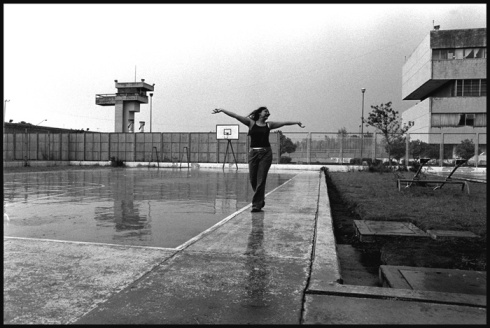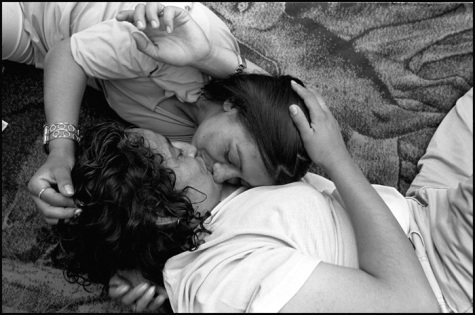
"Karla Liliana" 2005. Women's Prison "Reclusorio Oriente", Mexico City. © Patricia Aridjis
Patricia Aridjis spent over seven years on The Black Hours Project. She documented incarcerated women in the Mexican penitentiaries of Santa Martha Acatitla, Tepepan, “Reclusorio Norte & Oriente” and Michoacan Prison in Mexico City.
It is not only the photographs that Aridjis uses to tell the women’s stories with familiarity and sensitivity. Aridjis also compiled a video archive and a correspondence archive; I urge you to listen, read and pause.
I contacted Patricia and she generously gave permission to publish works from The Black Hours. It gives me great pleasure to do so, as her motivation bear striking similarity to a core principle of Prison Photography; to present imagery that jolts viewers into reassessments about prisons and the lives and stories therein.
Aridjis has been described as one of the photojournalists most committed to social issues in Mexico. It has also been explained that this project was a point of revelation in her career; Aridjis [coming to] understand prisons as only reflections of outside society:
The female penitentiary is more than a place where society hide its errors and cleans its faults; inside there are hundreds of stories of abandonment, abuse and even love.
Exhibition Board, Nacho Lopez Hall, INAH National Photographic Library
Aridjis’ photographic philosophy is clear, “To Make Visible, the Invisible”. Mexico’s penal system exerts control over what can and can’t be seen mimicking the practices of parts of the American penal system.

© Patricia Aridjis

© Patricia Aridjis
Photographers Statement
To do this photo essay I thought about being for long hours inside some women’s prisons in Mexico City. I considered that that was the only way to capture the feelings that go around the cells and corridors of these places. Loneliness, lesbianism as a way of satisfying affective needs; self punishment and suicide attempts are like gaping wounds in the wrists that cry for help. Drugs to escape reality, maternity, solidarity. Life is limited by watching towers, guards, gates and schedules. The black hours. My commitment found its exact words when I took an inmate’s picture in her cell. She asked me to be photographed because that was to be her only way out of there.
Patricia Aridjis, Mexico 2004

© Patricia Aridjis

"Mario (Maria) and Eli" 2000. Tepepan Women's Prison, México City. © Patricia Aridjis
Where is Jail?
“What would you do if I mugged you?” Natalia asked mischievously.
“You wouldn’t.” I answered. When Juan Carlos the inmate’s five-year old son over heard us he screamed, “Don’t do it mom! Don’t! Or you’ll end up in jail!”
“Jail does not exist.” she said after a brief silence.
“Where is jail?” I asked the boy who was inside his mother’s cell. “Outside, where the policemen are” he answered, pointing out to the window.
Talking with Natalia & Juan Carlos
Womens Prison, Tepepan, Mexico City, 2002.

© Patricia Aridjis
Time
To enter you have to walk through a long tunnel which leads to an almost completely feminine world, a world with no living colors, but beige and navy blue of the uniforms.
“I have been here seven years, four months and two weeks.” Exact, endless counting. Time that passes slowly and suddenly has turned into years ‘the black hours’.
Visitors are special; they are a breath of fresh air, freedom that comes from the outside.

"Cereso", 2004. Mil Cumbres, Prison Michoacan, Mexico. © Patricia Aridjis
Children
Some children have been born inside and their eyes have not seen any other light than the one that passes though the bars, especially those that have no one to take care of them. If such is the case they remain under the custody of government institutions until the legal system says otherwise.
“Dulce, Why are you in for?”
“Drugs.”
“How many years did they give you?”
“Ten.”
“Where did they get you?”
“At the airport.”
“How much did you have on you?”
“Two kilos.”
“What is your cause?” [sic]
“My mom… Maria.”
These are the words that Dulce, a four year-old girl memorized. She was born during her mother’s conviction.

© Patricia Aridjis
Objects, People, Spaces
Objects acquire a different value once they pass through the gate. Either because they are not allowed, such as scissors, perfumes in glass bottles, mirrors, or because they are outrageously expensive, like soap, deodorant or toilet paper. A phone card is like gold; the telephone is one of the few ways to keep in touch with the outside world. Family visits are another, but it is common that their partners or even their closest relatives abandon the inmates.
Beds have to be earned. Each cell houses about 15 inmates and is no more than 9 square meters. There are people sleeping on the floor and under the beds. As they leave, the ones that have been there longer get the beds. Other way to obtain this privilege is to buy it from someone who has been there more time.

© Patricia Aridjis
Love in the Time of Jail
Silvia and Claudia met in prison, they fell in love. They have loved each other night and day … intimacy is a very public thing in prison. Silivia did her time, soon after the relationship began. She could not bear to be free without Claudia – the love of her life – and planned a simulated burglary. She asked a friend to press charges so that she could be in prison again, and together again with Claudia.

"Silvia and Claudia" 2004. Women's Prison, "Reclusorio Oriente", Mexico City. © Patricia Aridjis
Biography
In 2006, Aridjis obtained the sponsorship of Revelaa Spanish organization which supports social justice photography. In 2002, she received a Grant for the Encouragement of Cultural Projects from FONCA (National Fund for Culture and Arts). That same year she won 1st place in the Anthropological Photography Contest awarded by the National School of History and Anthropology. In 2001, she received 1st place in the 5th Biennale of photojournalism. In 1994, Aridjis obtained a Grant for Young Creators (FONCA). She has been part of over sixty group & solo exhibitions.
Aridjis has recently been praised for her project The Sickness Behind Every Flower, which examines the use and toxic side effects of pesticides in agriculture.

8 comments
Comments feed for this article
April 15, 2009 at 6:16 am
Brent
What an incredible body of work. You are providing a great service here and it’s appreciated.
Thanks for your comment on my blog. You must share with me how you found the posting so quick!
Brent
April 15, 2009 at 12:56 pm
Sven
Pete, these are amazing photos, I felt them really deep in my gut!
May 9, 2009 at 3:05 pm
mary
I was in Santa Marta Actilla from May 1973-77. Anyone out there?
March 31, 2010 at 3:07 pm
POSI+TIVE MAGAZINE > Reportage > Prison Photography
[…] I am also proud of my analyses of Jean Gaumy Cornell Capa Jane Evelyn Atwood Jenn Ackerman and Patricia Aridjis […]
May 19, 2010 at 8:28 am
alfred
Incredible work, amazing photos, so deep, so human.
May 25, 2010 at 12:19 pm
Adolfo Cruz
Excellent document!
August 17, 2011 at 12:28 am
Mexico’s Drug War, Feminised: Portraits by Katie Orlinsky « Prison Photography
[…] being in front of a mirror.” Melania Comoretto and Women Prisoners – Neelakshi Vidyalankara – Patricia Aridjis: The Black Hours / Las Horas Negras – Prison Nursery, Ohio Reformatory for Women, by Angela Shoemaker […]
May 15, 2012 at 1:11 pm
ENCARCELACION: The Global Post Looks at “Latin America’s Fatal Prison Problem” « Prison Photography
[…] portraits of Mexican female prisoners – Fabio Cuttica at a Columbian prison beauty pageant – Patricia Aridjis in Mexico – even Cornell Capa was in Latin American prison at one […]